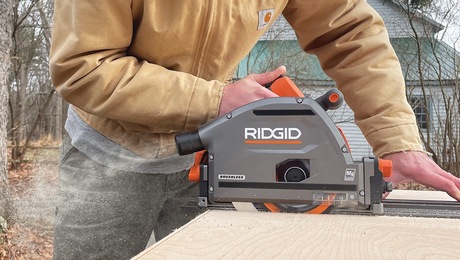Installing ceiling speakers in current project and can not come up with a good way to preserve my vapor barrier. One other problem is the open back of the speaker and the loose fill insulation that is specified. this is also zone 4 construction we look at extended temps of -20. speaker are niles cm730dsc.
Discussion Forum
Discussion Forum
Up Next
Video Shorts
Featured Story

The best tool for straight, splinter-free cuts is made even better without a cord.
Highlights
"I have learned so much thanks to the searchable articles on the FHB website. I can confidently say that I expect to be a life-long subscriber." - M.K.

















Replies
If you aren't able to find a pot light can big enough, I would make plywood boxes to hold the speakers. Caulk all joints and seal to the vb. In addition to the loose fill insulation you will want to cover the box with a couple of inches of rigid.
Edit: You might want to check the opening in the ceiling conforms to the code as far as penetrations and doesn't require a rated enclosure as a firestop.
Edited 9/4/2008 5:21 am ET by fingersandtoes
I'm thinking options here ... I've seen people use e.g. rigid thermax fabricated into a box instead of the plywood. Also ... I'm thinking creatively ... plastic, fiberglass. Can't you just buy some cheap/inexpensive plastic bowls or bowl like objects to use ... glue them to the ceiling ... voila. Kitchen bowls ... but there has to be a bunch of similar type products that also would work. Some thin plastic ... don't they make this type of product for this type of application? I'm thinking thin clear plastic that is just roughly formed into a bowl shape.
It's important to glue/seal it to the ceiling ... more maybe for acoustics than otherwise. How about irrigation system valve boxes? not the heavy green ones ... don't they make lighter white plastic? .... HOW ABOUT THE TEMPORARY COVERS THEY USE TO POUR CONCRETE AROUND BATHTUB DRAIN PLUMBING ... about a foot square and about 8 inches deep. Very lightweight and inexpensive ... just saw a friend use them. They might be just the ticket ... no fabrication ... reasonably durable ... covered w/ insulation and you may have a good acoustic enclosure, too.
Just trying to think creatively to generate options. I'll bet some of the guys out there can think of 2 dozen more ways to do this in a simple way. You'd think they'd sell this with the ceiling rings they sell. You may want to enhance acoustics with a bit of fiberglass batt inside the enclosure ... I made some wood speaker enclosures once and fiberglass really enhanced the sound and avoided that tinny sound of a hard wood box.
How about styrafoam coolers?
Nice idea!! Technically, though, the surface of any styrofoam must be "in substantial contact" with e.g. sheetrock or other approved material. Firecode. Probably the same for my idea of using the plastic box ... unless that plastic box has an approved flame spread rating.
foam it to the sheetrock
I meant the surface of the cooler, not just the lip/edge.
Just to muddy up the water a little further.......
Keep in mind that most in-wall speakers are designed to 'see' a large volume of air within the stud void. If you diminish the air volume behind the speaker, the response of the speaker may be altered. Likely less bass.
Meh, so what. It's an in-ceiling speaker; I don't think the object is jaw-dropping fidelity.
Right, but if you treat it too casually ... you could end up with something very undesireable ... tinny sound or buzzing if the enclosure for example was not sealed properly (e.g. a lightweight plastic enclosure just sitting on the DW ceiling might give quite the rattle/buzz.
What about a box out of sheetrock scraps and foil tape...fire resistant, and acoustically dense. Get really fancy and build it with a base reflex channel...
Steve
I like the drywall idea.
I saw these ONSIA speakers at the February IBS in Orlando truely amazing sound from something that looks and installs like a 2' x 2' square of sheetrock. completely invisible and has an auto reset breaker inside to protect them from overload. sold at Lowes http://www.lowes.com/lowes/lkn?action=productList&N=0&Ntk=i_products&Ntt=Onsia
I've been trying to sell them to my clientele but nobody wants to "risk it" since it's something new. I think I'll have to install a couple in my work shop (my home and office don't have any sheetrock, all wood walls and ceilings) only my shop has a sheetrock ceiling I could set the speakers into.
Since they are only a half inch thick you just cut out a 2'x2' chunk of sheet rock and wire them in like a recessed speaker only without the recess. and without damage to the vapor barrier.
As to the wisdom of a vapor barrier, that's a whole 'nother question. We don't use them here in NC and I think Joe Lstiburek at Building Science Corp makes a pretty good argument against them in much of the US.
------------------
"You cannot work hard enough to make up for a sloppy estimate."
We used those on one job, they work great!
Joe L. does suggest eliminating the vapor barrier, but advocates using vapor-retarding latex paint. Penetrations should be sealed--easy with the speakers you show, but more difficult with other ceiling fixtures.
But you already knew that ;-)
I used pink foam and great stuff to make boxes behind the speakers (JBL 9 inchers) then great stuffed to the ceiling sheet rock. They sound great, nice to not have speakers on the floor.